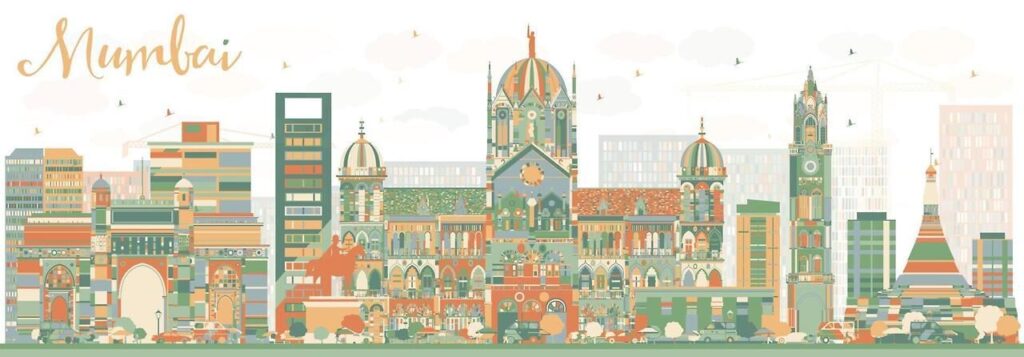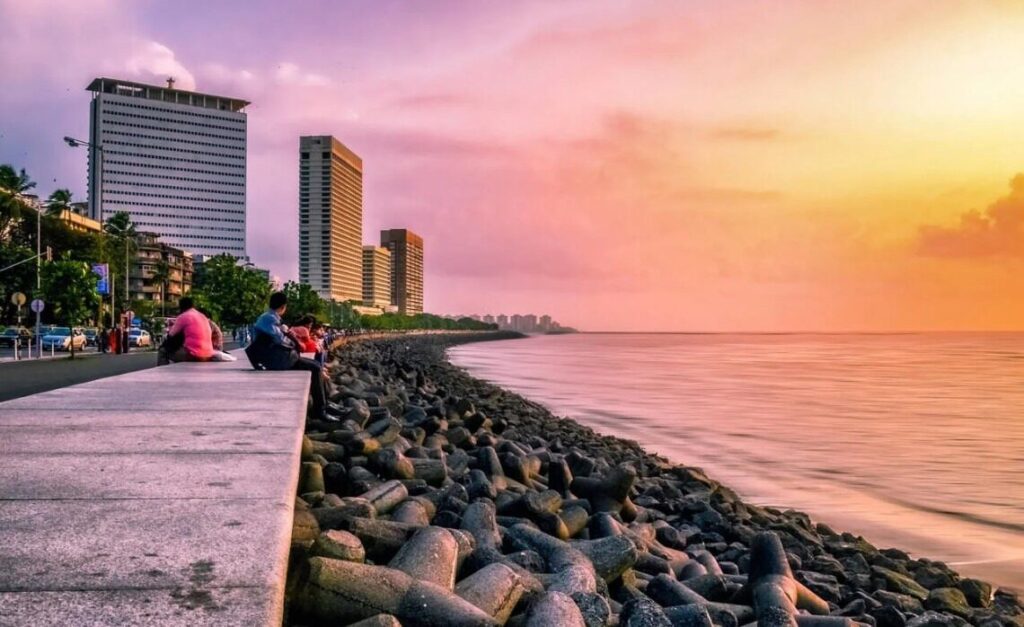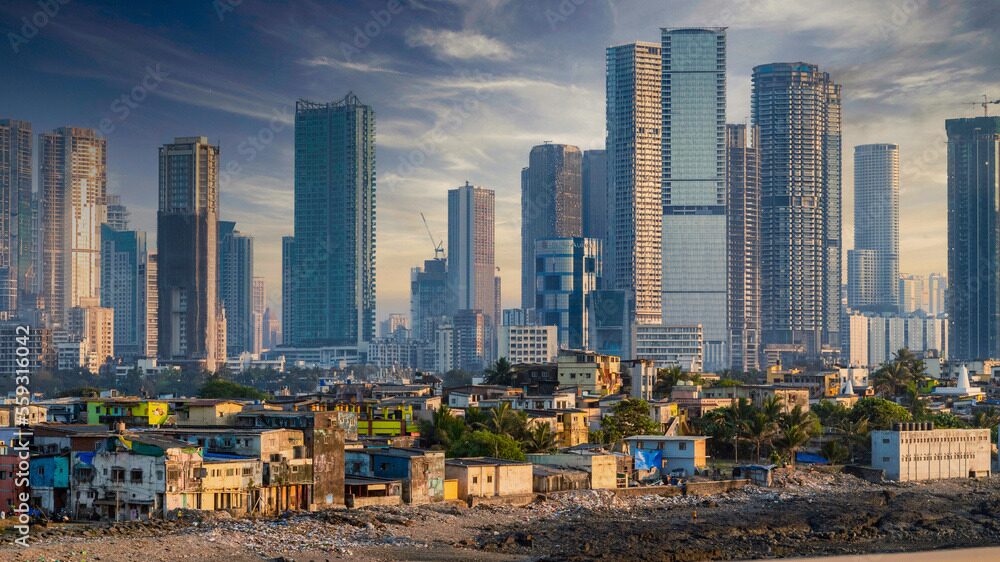📍Mumbai is one of the world’s most densely populated megacities, with approximately 22.08 million people, serving as a megacity centered around finance, manufacturing companies, and Bollywood entertainment.

1. City Overview
- Population: The estimated population for 2025 is 22,089,000, with the metropolitan area including approximately 21-22 million people. In 2011, the urban agglomeration (UA) population was 20.7 million, and the city’s population itself was 12.48 million.
- Area: The city area is approximately 603 km², while the metropolitan region spans 6,328 km².
- Language: Marathi and English are the official languages. Other languages used include Hindi, Urdu, Gujarati, and 16 other languages. A street Hindi dialect called ‘Bambaiya’ also exists.
- Religion: Approximately 66% are Hindu, 20.7% are Muslim, 3.3% are Christian, 4.9% are Buddhist, 4.1% are Jain, and 0.5% are Sikh.
- Literacy Rate: The illiteracy rate is low, with a literacy rate of approximately 90%.
- Gender Ratio: Approximately 853-863 females per 1,000 males.
2. History 🕰️
- From Fishing Village to Port City (Ancient Times – 17th Century): Mumbai originally consisted of seven islands and was a fishing community primarily composed of Koli fishermen.
- Portuguese and British Colonial Rule (16th – 19th Century): In the late 16th century, the Portuguese occupied it. In 1661, it passed to British rule, after which it transformed into a trade center and rapidly grew.
- Industrialization and Railway Opening (19th Century): The railway opened in 1877, and the Chhatrapati Shivaji Terminus (CST) was completed in 1887, leading to its rapid rise as a port and railway hub.
- Film Industry and Modern Era (20th Century – Present): Since the 1920s, it developed into the center of Bollywood. After financial liberalization in the 1990s, it established itself as a global financial hub.

3. Geography
- Coastal and Island Structure: Located on the Arabian Sea in western India, it was originally seven islands that were integrated through land reclamation and bridges.
- Urban Administrative Divisions:
- South Mumbai: The central business and tourism hub.
- Suburbs (Thane, Navi Mumbai, etc.): Residential and industrial centers.
- Mumbai Metropolitan Region (MMR): Includes 9 cities, 9 councils, and over 1,000 villages.
- Climate & Natural Environment: It has a tropical monsoon climate, with an average annual temperature of 27°C and annual rainfall of 2421 mm. The city faces climate risks such as sea-level rise, floods, and urban inundation.
4. Culture
- Linguistic and Multicultural Melting Pot: 16 languages coexist, and the ‘Bambaiya’ slang is actively used. It is a city of diversity, largely due to its immigrant population.
- Film and Theater Hub: It is the headquarters of Bollywood (Hindi cinema), with major studios like Goregaon Film City and RK Studios concentrated there.
- Diversity of Religious Festivals: The city is filled with year-round festivals, including Hindu Pujas, Islamic Ramadan, Christian Easter, and Sikh festivals.
5. Environment
- Air, Noise, and Water Pollution: Mumbai is one of the world’s noisiest cities, and it experiences significant issues with traffic congestion, air pollution, and flood risks.
- Slums & Housing Shortages: Over 42% of citizens reside in slum areas like Dharavi. High density and poverty remain ongoing challenges.
- Transportation and Climate Response: Efforts include the expansion of metro, monorail, and bus services, as well as strengthening infrastructure to prevent floods and overflows. Mumbai is India’s first “2050 Net Zero City” and is implementing systematic carbon reduction strategies across energy, transport, water, and green space sectors through MCAP.
6. Economy
- Economic Scale & Industrial Structure: Nominal GDP is approximately $278 billion USD, with a PPP of $400 billion USD. It accounts for 6.16% of India’s GDP, with high concentrations in manufacturing, finance, trade, and entertainment.
- Financial Hub: Mumbai is home to the Bombay Stock Exchange, Reserve Bank of India, National Stock Exchange, and the headquarters of major corporations like Tata and Reliance.
- Foreign Investment & Infrastructure Investment: Foreign Direct Investment (FDI) plays a leading role in the entire Maharashtra state, and investments in infrastructure projects such as the Navi Mumbai airport and the Trans-Harbour Link are expanding.

7. Key Locations
- Historical and Architectural Landmarks
- Gateway of India: A monumental arch commemorating a British royal visit.
- Chhatrapati Shivaji Terminus (CST): A Victorian Gothic architectural heritage site.
- Victoria Terminus (near CST).
- Film and Art Districts
- Film City, Kala Ghoda area, Art Deco building clusters.
- Slum Areas
- Dharavi: A center for textile, leather, and recycling industries, home to approximately 1 million people.
- Financial CBD
- Bandra Kurla Complex (BKC): A high-end business district with world-class offices.
- Beaches & Outdoor Attractions
- Marine Drive, Juhu Beach, Chowpatty Beach: Popular recreational spots for citizens.
8. Conclusion
Mumbai stands as a representative Indian megacity, wielding overwhelming influence in the finance, manufacturing, and entertainment sectors.
- Strengths: Global financial hub, Bollywood center, diverse culture, high literacy rate.
- Challenges: Slums and poverty, transportation and housing issues, floods, and pollution.
- Future Strategy:
- Expansion of public transport (metro, monorail), with plans for a water transport network modeled after the Kochi Water Metro. Projects like the Panvel–Karjat railway, Coastal Road, and Trans Harbour Link (MTHL) are being expedited.
- Slum redevelopment and housing expansion policies.
- Strengthening flood and pollution infrastructure for climate response, as Mumbai is India’s first “2050 Net Zero City”.
- Sustainable urban growth and smart city transition.
